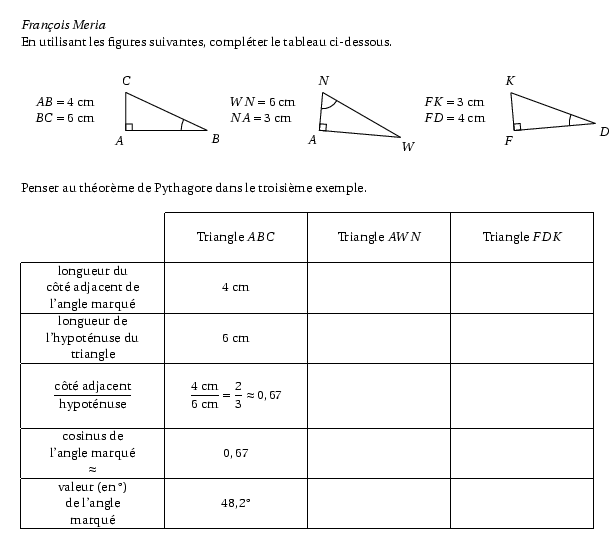Modifié le 22 Octobre 2006 à 22 h 51.

Source
%@Auteur: François Meria\par
En utilisant les figures suivantes, compléter le tableau
ci-dessous.
\vskip 1.5cm
\begin{multicols}{3}
\begin{tabular}{ll}
\pspicture(0,-1)(2.5,1)
\put(0,0.5){\begin{tabular}{l}$AB=4$~cm \\ $BC=6$~cm \end{tabular}}
\endpspicture
&
\psset{unit=1cm}
\pspicture(0,-1)(2.5,1)
\pstGeonode[PointSymbol=none,PosAngle={235,-45}](0,0){A}(2.5,0){B}
\pstGeonode[PointSymbol=none,PointName=none](0,0.5){T}
\pstRotation[RotAngle=-25,PointName=none,PointSymbol=none]{B}{A}{S}
\pstInterLL[PointSymbol=none,PosAngle=90]{A}{T}{B}{S}{C}
\pstRightAngle[RightAngleSize=0.2]{B}{A}{C}
\pstLineAB{A}{B} \pstLineAB{A}{C} \pstLineAB{B}{C}
\pstMarkAngle[MarkAngleRadius=0.8]{C}{B}{A}{}
\endpspicture
\\
\end{tabular}
\begin{tabular}{ll}
\pspicture(0,-1)(2.5,1)
\put(0,0.5){\begin{tabular}{l}$WN=6$~cm \\ $NA=3$~cm \end{tabular}}
\endpspicture
&
\psset{unit=1cm}
\pspicture(0,-1)(2.5,1)
\rput{-5}{
\pstGeonode[PointSymbol=none,PosAngle={235,-45}](0,0){A}(2.5,0){W}
\pstGeonode[PointSymbol=none,PointName=none](0,0.5){T}
\pstRotation[RotAngle=-25,PointName=none,PointSymbol=none]{W}{A}{S}
\pstInterLL[PointSymbol=none,PosAngle=90]{A}{T}{W}{S}{N}
\pstRightAngle[RightAngleSize=0.2]{W}{A}{N}
\pstLineAB{A}{W} \pstLineAB{A}{N} \pstLineAB{W}{N}
\pstMarkAngle[MarkAngleRadius=0.5]{A}{N}{W}{}
}
\endpspicture
\\
\end{tabular}
\begin{tabular}{ll}
\pspicture(0,-1)(2.5,1)
\put(0,0.5){\begin{tabular}{l}$FK=3$~cm \\ $FD=4$~cm \end{tabular}}
\endpspicture
&
\psset{unit=1cm}
\pspicture(0,-1)(2.5,1)
\rput{5}{
\pstGeonode[PointSymbol=none,PosAngle={235,-45}](0,0){F}(2.5,0){D}
\pstGeonode[PointSymbol=none,PointName=none](0,0.5){T}
\pstRotation[RotAngle=-25,PointName=none,PointSymbol=none]{D}{F}{S}
\pstInterLL[PointSymbol=none,PosAngle=90]{F}{T}{D}{S}{K}
\pstRightAngle[RightAngleSize=0.2]{D}{F}{K}
\pstLineAB{F}{D} \pstLineAB{F}{K} \pstLineAB{D}{K}
\pstMarkAngle[MarkAngleRadius=0.8]{K}{D}{F}{}
}
\endpspicture
\\
\end{tabular}
\end{multicols}
Penser au théorème de Pythagore dans le troisième exemple.
\vskip 0.5cm
\begin{center}
\begin{tabularx}{\textwidth}{|>{\centering}X|>{\centering}X|>{\centering}X|>{\centering}X|}
\cline{2-4} \multicolumn{1}{c|}{} & & & \\
\multicolumn{1}{c|}{} & Triangle $ABC$ & Triangle
$AWN$& Triangle $FDK$ \tabularnewline
\multicolumn{1}{c|}{} & & & \tabularnewline \hline
longueur du & & & \tabularnewline côté adjacent de & 4~cm
& & \tabularnewline l'angle marqué & & &
\tabularnewline \hline longueur de & & & \tabularnewline
l'hypoténuse du & 6~cm &
& \tabularnewline triangle & & &
\tabularnewline \hline
& & & \tabularnewline
$\dfrac{\textrm{côté adjacent}}{\textrm{hypoténuse}}$ & $\dfrac{4~\textrm{cm}}{6~\textrm{cm}}=\dfrac{2}{3}\approx 0,67$ & & \tabularnewline
& & & \tabularnewline
\hline cosinus de & & & \tabularnewline
l'angle marqué & $0,67$ & & \tabularnewline
$\approx$ & & & \tabularnewline \hline valeur (en °) & & &
\tabularnewline de l'angle & $48,2$°
& & \tabularnewline marqué
& & & \tabularnewline \hline
\end{tabularx}
\end{center}